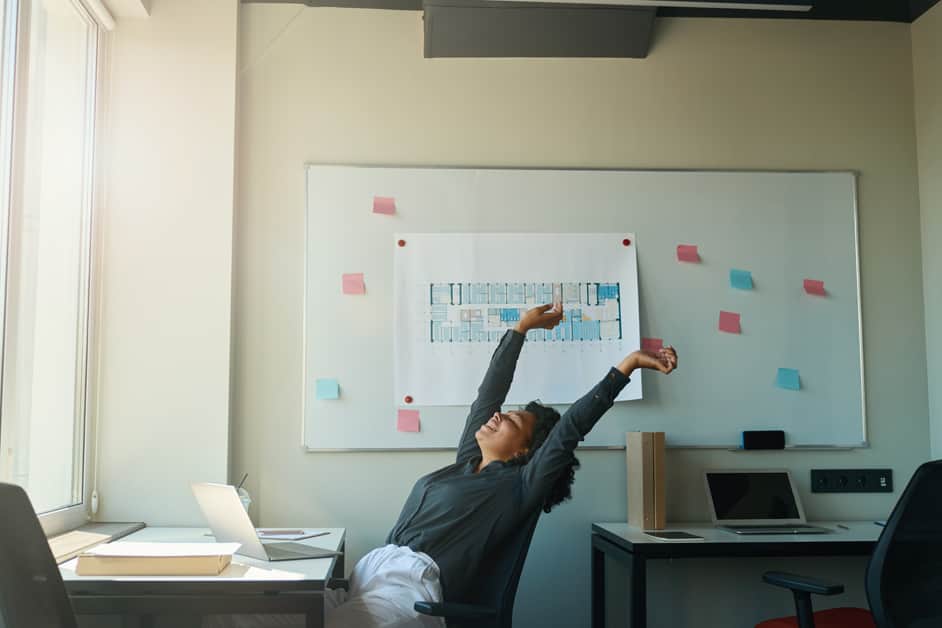Introduction
This guide will help protect knees from discomfort and injury. It’ll give advice on how to make adjustments to your workplace for better knee health.
Good posture and ergonomics are important for bodies to work correctly and efficiently. That’s true even if you spend most of the day sitting at a desk.
This guide is divided into four main sections:
- Select the right equipment: chairs that promote healthy habits and adjustable footrails for extra leg support.
- Set up your workspace: focus on chair position for comfort.
- Knee-friendly movements: regular breaks and stretching.
- Physical training: ways to strengthen muscles for better protection.
Combine knowledge from all topics to keep knees strong and prevent long-term injury or discomfort.
Assess Your Work Environment
Poor ergonomics in the workplace can lead to knee pain. Therefore, it’s vital to assess your workplace. Check the chair, keyboard, mouse, monitor and other elements.
After surveying your workspace, make changes to avoid knee pain from long sitting.
Adjust your chair
Adjust your chair to fit the curves of your spine. It should be adjustable to fit you. Put your feet flat on the floor or on a footrest if your seat is higher. Recline it slightly to take pressure off your spine and hips.
For extra support, add a lumbar cushion. It will help with posture and reduce pain from sitting for long periods. Adjust the tilt of the seat too. It’ll make it easier to switch your weight from one side to the other.
Keep items used for work ‘close by’. About an armlength away is perfect so you don’t strain to reach them.
Adjust your desk
Relieve knee pain and aid comfort with an ergonomic workspace. Make desk adjustments for optimal working environment.
- Start with a chair. Choose one that is adjustable for width, depth, angle, height and lower back support. Add armrests to reduce strain on wrists and arms.
- Desk height should be level with elbows when sitting in the chair. Tilt desk surface for comfortable typing posture. Replace mouse with an ergonomic one for improved comfort.
- Raise computer monitor off desk. Keep extra items in drawers or storage cabinets. This minimizes office clutter and prevents painful bending or twisting while reaching for something. All of these help with knee comfort levels.
Adjust your monitor
To reduce knee pain, adjust your computer monitor height. Monitors are designed for sitting, so they should be at eye level when you’re in the correct posture. Hunching forward adds stress to hips, shoulders and neck, which can hurt your knees. Keep an arm’s length between you and the monitor when sitting.
To check if your monitor needs adjusting:
- Sit upright in a supportive chair
- Rest arms comfortably on either side
- Make sure the top is level with or slightly below eye level
- Check the middle is comfortable for reading without forcing head up or down
- If needed, use a desk mount to raise or lower the height
- Ensure there’s space between you and screen for air movement without causing glare.
Utilize Ergonomic Accessories
Ergonomic accessories can reduce knee pain in the workplace. Lumbar supports, adjustable desks and footrests can minimize strain on your body. They also have the added benefit of helping to improve posture and muscle alignment. This can lead to increased productivity!
So, let’s investigate how these ergonomic accessories can help reduce knee pain in the workplace:
Invest in a footrest
An ergonomic footrest is important for an optimal workspace. It supports your feet, so they stay parallel to the floor. This helps your shoulders relax and your neck stay neutral. It also helps maintain proper sitting posture. This reduces pressure on back and spine, and relieves any muscle strain or fatigue.
Adjust the height of the footrest to fit your body type. Make sure the material is durable and comfortable. It should support the arch area of both feet.
Invest in a wrist rest
A wrist rest is great for reducing strain. People often overwork their wrists when typing a lot. By using a cushion, you can reduce pain from MCP joint arthritis.
To use it correctly, place it under your palms when typing or clicking on the mouse.
Wrist rests come in different shapes and sizes for gaming keyboards, office desks and laptops. Choose one that fits your workflow, giving you enough space to move. Pick one that is non-slip and warm, made from natural materials like leather or fabric instead of plastic for extra comfort.
Invest in an ergonomic mouse
Standard mice or trackpads are usually used when typing on a computer. But, for comfort and injury prevention, an ergonomic mouse is the way to go. It is designed to fit your hand shape and reduce muscle strain in your wrists and forearms. It should be comfortable, not requiring you to bend your wrist or reach too far from your body.
Ergonomic mice come in various shapes and sizes. For example, vertical mice and ambidextrous mice. With a vertical mouse, you rotate your arm, instead of twisting it. An ambidextrous mouse works for both left-handed and right-handed users. Ensure the device you select fits comfortably in either hand with no pressure on the palm area.
When selecting an ergonomic mouse, look for features that offer maximum support. Such as
- adjustable angles,
- pointer speed settings,
- contact containment shells,
- cushioned pallets,
etc. When used correctly, these tools will help reduce strain on your wrists and promote neutral body posture during long hours at work. This can help improve overall knee health by decreasing discomfort due to prolonged sitting.
Take Regular Breaks
Regular breaks while working can help reduce knee pain. Get up and move around! This gives your leg muscles a chance to regulate. Stretching for a few minutes can boost circulation, decrease cramping, and prevent leg and knee fatigue.
This guide provides tips on how to structure your workspace to manage knee pain:
- Take breaks!
Stand up and move around
Working at a desk or computer station can cause knee pain. To prevent this, take regular breaks. Every forty minutes, stand up and move around for five minutes. This helps reduce knee pain by taking the load off the joints. Change positions every half-hour – alternating between sitting and standing. It also helps improve posture.
If you have the space, walk around the office during each break. This helps lubricate joints and reduce inflammation. Alternatively, do some simple strengthening exercises like squats or wall sits. These help maintain good knee health and produce stronger leg muscles!
Take short walks
Take short walks round the office or stand up from your desk. This will help your overworked, stressed joint muscles. Work continuously? Take a five-minute break. It’ll ease tension in your joint muscles and encourage movement, reducing pain.
Make these breaks count. Go for a short walk away from your desk. Get some fresh air. Change positions. You’ll not only give your body a break but clear your head, preparing for productive work later. Plus, walking around has health benefits, increasing blood circulation in the legs and boosting oxygen flow throughout the body.
Stretch your legs
Take regular breaks from sitting to reduce knee pain. Stretching adds movement to your day and helps reduce stress on the knees. It also helps with stiffness, circulation and releasing tight muscles in the lower back, hips and legs.
Do these simple leg stretches every hour:
- Calf stretch: Put your hands on a wall at chest height and step back with one foot. Flex the foot for 10 seconds and switch feet.
- Shoulder crossover: Cross one arm across the chest near the armpit. Gently press down until you feel a mild stretch. Hold for 10 seconds, then switch sides.
- Hip flexibility stretch: Stand facing away from any obstacles. Cross one leg over the other and drop into a squat. Feel an easy stretch across hips. Keep core engaged. Tip-toe if needed.
Seek Professional Help
Seek help to manage knee pain due to sitting too long. See a physical therapist! They will make a plan just for you. This will help with the pain, reduce any more harm, and protect your knee.
Working with a pro makes sure you use ergonomics right. Plus, they will suggest the best exercises and habits to help you.
Speak to an ergonomics specialist
Knee pain can arise from standing or sitting for too long. It is important to understand the cause and how to relieve it. An ergonomics specialist can help. They review your job, workspace, and medical history. Then they suggest solutions like resting one foot on a stool while standing. They might recommend buying items like cushions, braces, or insoles. They can also teach you safe lifting techniques and how to adjust your posture throughout the day.
Ergonomists have info about workplace program management, product design, and task performance. Take care of yourself now – talk to an ergonomics specialist!
Visit a physical therapist
Knee pain at work? Your first move should be to go see a physical therapist. They’ll assess your posture, running gait and any ergonomics you might need. In some cases, they can offer treatments like electrical stimulation that help reduce inflammation.
Plus, they can give you exercises to strengthen muscles and tendons around your knee. They’ll also suggest ergonomic changes, like adjusting the computer monitor’s height. Custom orthotics or supports may be recommended, too.
A physical therapist will decide what works best for you. Many conditions improve with stretches and exercises. But visits with a physical therapist are essential for resolving symptoms quickly and preventing future episodes.
Consider a custom orthotic
Persistent knee pain? A custom orthotic might be the answer. It’s made of hard plastic and fits inside your shoe, providing cushioning and support. This reduces pressure on the knee joint, easing discomfort from long periods of standing or walking.
Custom orthotics are tailored to your foot structure, for greater comfort than over-the-counter inserts. A podiatrist takes measurements and images, and suggests one or more designs. It takes several weeks to craft and deliver it.
Regular use of the device can help relieve pain from walking, standing and activity. So you can keep up an active lifestyle without risking injury to your knees.
Frequently Asked Questions
Q: What can I do to reduce knee pain at work?
A: To reduce knee pain at work, try to sit in an ergonomic chair and position your chair so that your feet are flat on the floor and your thighs are parallel to the ground. Additionally, try to get up and walk or stretch periodically throughout the day.
Q: Are there any ergonomic products that can help with knee pain?
A: Yes, there are ergonomic products such as footrests, adjustable desks, and kneeling chairs that can help reduce knee pain while you are working.
Q: What should I do if my knee pain persists?
A: If your knee pain persists, consult with a doctor to determine the cause of your pain. Additionally, they may be able to provide you with more information on what specific ergonomic products or modifications you can make to reduce your knee pain.





